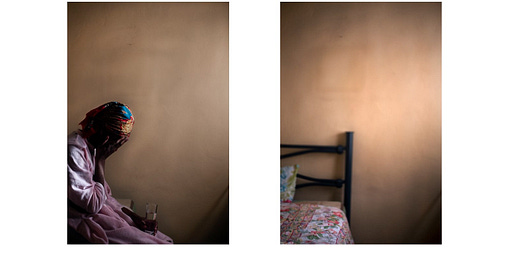Two views of a bare room. Its austere mood has as much to do with a simple furnishing—the half of a bed-frame against a dull yellow wall—as with the nearly-full glass of water held by a sitting, hunched-over figure. Even the fact that there is no forward glance from the sitter says something about the plaintive scene. These observations combine to make the picture less descriptive than evocative, a marker for a grief observed.
— Emmanuel Iduma
“My approach to photography is to observe, listen and have the humanity to tell my story.”
This photograph is a self-portrait from my body of work “Tuesday Afternoon,” where I explore emotions I endured after the passing of my mother when I was 9 years old. This image was taken in the bedroom where she lost her life. I was reminded of the sight of my grandmother and revisited these emotions by wearing my grandmother's gown and my mother’s headwrap. A self-timer and tripod made it possible. My emotions were sincere as I was in a bad place and missing my mother.
My approach to photography is to observe, listen and have the humanity to tell my story and those of others in a way that is as authentic and truthful as possible.
Photography is a powerful medium that can stir emotions, capture moments, convey messages, and form perceptions. The power of photography is in its ability to capture and transmit moments, emotions, and narratives. It is a truly influential media in our visual culture since it serves as a potent tool for education, inspiration, social change, and personal expression.
— Xoliswa Ngwenya
About Xoliswa Ngwenya
Xoliswa Ngwenya is a visual artist, photographer and archivist based Johannesburg, South Africa. “My love for humanity and interest in human behaviour and psychology have prompted me to major in anthropology and records and archives management, which manifests itself in my photography,” he says. See more of his work on Behance and Instagram.
Last Week — “Church on the Greenwich Meridian,” by Edem J. Tamakloe
I was drawn to the juxtaposition of the large, rigid pattern of apertures in the breeze blocks with the texture of tiny grey pebbles in the terrazzo on the building’s façade.
This static montage contrasted intriguingly with the fluid movement of people pacing up and down the length of the church yard, as they went through the stages of the application process.
SUPPORT TENDER PHOTO
This is the 70th edition of this publication, which also read on web (best for viewing images), and via the Substack iOS/Android apps.
Every Wednesday I feature one photograph and the photographer who took it: you’d read a short caption from me, and a statement from the photographer. And every Saturday I publish a lengthier engagement with photography, such as the recently concluded CORRESPONDENCES. Between June 3–July 29, I’m writing a series of micro-essays in response to sequences of photographs previously featured on the newsletter.
Photographers can now submit their work for consideration.
My hope is to engage with early to mid-career African photographers, and to create a platform in which photographers lead the cataloguing and criticism of their work.
Thank you for reading. If this newsletter was shared with you, consider subscribing, or forward to a friend. Please whitelist the newsletter to ensure you never miss it.






I think this is my favourite Tender Photo post yet! Thank you!